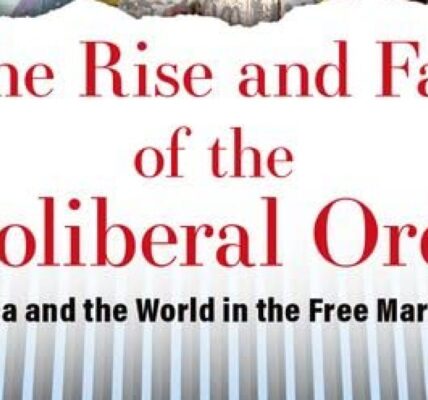Globalists tackles the historical development of neoliberalism not as a rejection of state power, but as a strategic redeployment of it to protect global capitalism from democratic interference. Quinn Slobodian, a historian at Wellesley College, adopts a rigorous archival and intellectual-historical method to chart how economists and legal theorists—mostly from Central Europe—conceived a global order to safeguard markets in the post-imperial world. The book is rooted in the tradition of critical political economy but reframes neoliberalism away from the Chicago School and instead toward a lesser-known “Geneva School.” Structured thematically with chapters titled “A World of Walls,” “A World of Rights,” and so on, the book mirrors its central idea: that neoliberals thought in world orders, building institutions not to free markets, but to encase them.
Slobodian argues that neoliberalism was never about laissez-faire. Instead, it was an active, institutional project to protect capitalism from mass democracy, especially as empire gave way to a world of sovereign nation-states. Neoliberals like Hayek, Röpke, and Mises were less interested in shrinking the state and more concerned with constructing international legal regimes—from trade tribunals to investment protections—that would neutralize popular demands for redistribution. This reinterpretation of neoliberalism reframes it as a global constitutional project, not a local economic policy toolkit. In today’s world, where institutions like the WTO and IMF face backlash and populist movements push for national control, Slobodian’s historical lens feels urgently relevant: it reveals how the rules of globalization were designed from the outset to contain democracy, not reflect it.
The book stems from Slobodian’s academic exploration of neoliberal thought in post-Habsburg Europe, crystallizing years of archival research into figures who have been largely overlooked in Anglophone literature. His intent is clear: to rescue neoliberalism from caricature and to examine it on its own terms. Rather than treating neoliberal thinkers as ideologues of market “freedom,” Slobodian takes their anxieties about democracy and sovereignty seriously. With a focus on figures who worked in Geneva—home to GATT and later the WTO—Globalists extends its scope from intellectual history into legal and institutional analysis, spanning contexts from post-WWI Austria to post-apartheid South Africa.
Throughout the book, Slobodian links neoliberalism to key conditions like decolonization, global trade integration, and institutional design. He challenges the notion of “market fundamentalism” by showing that neoliberals always sought institutional encasement—not freedom from regulation but protection from democratic interference. The book traces how neoliberals responded to three main ruptures: the collapse of empire after WWI, the Great Depression, and the rise of the Global South in the 1970s. Slobodian masterfully shows how these thinkers reconceived sovereignty not as a national project, but as something that needed to be constrained from above to ensure the survival of capital.
Chapter 1, “A World of Walls,” sets the intellectual foundation by unpacking the interwar context that birthed neoliberal internationalism. Here, Slobodian traces how Mises and Hayek responded to the collapse of empires and the rise of economic nationalism with a vision of global rules over national autonomy. This chapter bridges political theory and economic ideology, revealing how neoliberals conceptualized global capitalism as a space that required discipline, not liberty. It’s a powerful ideological critique that reveals neoliberalism as a counterrevolution against democratic self-determination.
In Chapter 5, “A World of Races,” Slobodian explores Wilhelm Röpke’s racialized vision of world order. This chapter takes on a more psychological and cultural analysis, examining how Röpke—unlike other neoliberals—explicitly linked market civilization to Western Christian identity. It’s a disturbing but enlightening portrait of how some strands of neoliberalism rationalized inequality and segregation in moral and civilizational terms. Slobodian doesn’t shy away from the ideological discomfort, making this chapter a vital read for understanding the emotional and cultural undercurrents that animated the neoliberal worldview.
Chapter 6, “A World of Constitutions,” shifts to the legal and institutional terrain. Focusing on the European Economic Community and later the WTO, Slobodian shows how neoliberals like Ernst-Ulrich Petersmann viewed international law as a bulwark against economic nationalism. The chapter blends constitutional theory, economic policy, and trade law, showing how neoliberalism manifests not only in ideas but in juridical architectures. The Geneva School’s push for supranational economic law was less about deregulation and more about preventing domestic regulation—a critical insight for today’s debates on sovereignty and globalization.
While Globalists is conceptually robust and historically rich, some chapters feel densely theoretical, making it occasionally hard to trace cause and effect between ideas and policies. The overwhelming focus on elite thinkers means that grassroots neoliberal implementation or resistance is underexplored. Moreover, the book largely concludes in the 1990s, leaving readers to infer how these ideas played out in the post-9/11, post-2008, or post-COVID world. A fuller engagement with neoliberalism’s evolution into financialization or digital capitalism would have broadened the narrative.
Slobodian thoroughly critiques neoliberal globalists but does not deeply engage with their contemporary opponents—Keynesians, developmentalists, or democratic socialists—on equal terms. Their absence limits the comparative texture of the book. While the book shines in deconstructing neoliberal arguments, a more explicit dialogue with non-neoliberal visions of international order could have clarified what alternatives were available or attempted at each historical juncture. Including voices from the Global South might have also enriched the picture.
The book relies heavily on textual analysis and correspondence among elite European thinkers, which sometimes gives neoliberalism the appearance of a purely top-down, intellectual project. Though institutional traces (like GATT or the WTO) ground these ideas, there’s limited attention to how these policies were received, contested, or reshaped on the ground, particularly in the postcolonial world. While Slobodian acknowledges this limitation, broader engagement with empirical or ethnographic accounts of neoliberal implementation could have expanded its reach.
Globalists is a landmark work in the intellectual history of neoliberalism. Slobodian’s greatest contribution is to reframe the project not as an ideology of liberation, but as a system of legal, institutional, and geopolitical containment. His attention to the post-imperial context and international law moves the conversation beyond Chicago and Washington to Geneva—a shift that reshapes how we understand the neoliberal century. Despite some limitations in breadth and opposing perspectives, the book’s theoretical rigor and archival depth make it essential reading for anyone grappling with the legacy of global capitalism. It’s not just a history of ideas—it’s a blueprint of the institutions that still govern us.



